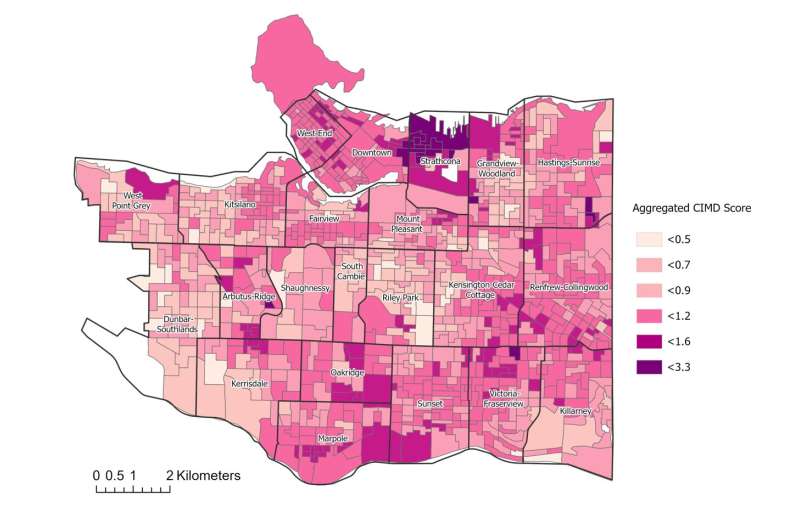This article has been reviewed according to Science X's editorial process and policies. Editors have highlighted the following attributes while ensuring the content's credibility:
fact-checked
peer-reviewed publication
trusted source
proofread
Q&A: New tool can reveal inequitable distribution of 'healing' green spaces

Areas in Vancouver with the greatest need for restorative nature often have the least exposure to it, according to a new UBC study published recently in Ambio. These neighborhoods include Strathcona, downtown Vancouver, the West End, southern Sunset and Marpole.
The researchers developed a new tool, the local restorative nature (LRN) index to assess spaces for the presence of qualities that promote mental well-being. While initially applied in Vancouver, the index can also be used in any urban landscape, according to lead author Dr. Tahia Devisscher, an assistant professor in the faculty of forestry.
We sat down with Dr. Devisscher to discuss the study findings and their implications for urban greening and mental health.
What led you to create the local restorative nature index? How does it work?
The LRN index is a new tool that is specifically designed to assess the healing qualities of green space. Research tells us that green spaces have many qualities that can promote mental well-being, but we don't have a systematic, location-specific method for assessing these qualities. We formulated the LRN index to enable us to do that.
The index assigns a score based on perceived sensory dimensions deemed important for mental health: "refuge," "wild nature" and "diversity." We developed proxy indicators for these dimensions based on tree and shrub biomass and density, green canopy coverage, water features and the diversity of tree species and vegetation types present in any given area.
These factors are associated with positive feelings and an easing of stress; they facilitate inward-directed, even "passive" activities that are restorative, such as strolling in the park or quietly contemplating nature. The higher a space scores across these dimensions, the more revitalizing it proves to be.
What did you discover when you applied the index in Vancouver?
Using the dissemination area—a census term representing approximately 250 households—as our unit of analysis, we observed that restorative green spaces are distributed unevenly across Vancouver. Neighborhoods like Shaughnessy, Dunbar Southlands and West Point Grey featured many dissemination areas with high LRN scores. Areas like downtown Vancouver and Strathcona had fewer dissemination areas with high LRN scores. As well, ethnically homogenous dissemination areas tended to display higher LRN scores.
More importantly, we found that areas with the greatest need for restorative nature often have the least exposure to it. When we compared LRN scores in different neighborhoods with their socioeconomic vulnerability, we noticed that more vulnerable neighborhoods typically had lower LRN scores.
Hotspots marked by both higher vulnerability scores and low LRN scores included Strathcona, Downtown, West End, southern Sunset and Marpole. Urban planners may want to pay special attention to these neighborhoods when developing greening aimed at improving mental well-being.
For our study, socioeconomic vulnerability was assessed by combining census data, including housing types, employment rates and cultural diversity. Neighborhoods with a higher proportion of rental housing, lower employment rates, or greater ethnocultural diversity tended to receive higher vulnerability scores.
What other trends did you observe?
We found a distinct gradient running from west to east in the city. In the northwest areas of the city, where homeownership was more prevalent, there was also greater availability of restorative natural spaces. In the southeastern neighborhoods, where rental buildings predominated, there was less availability of restorative green space.
One surprise was that there were areas with higher unemployment rates or lower financial resources that had more exposure to green spaces, and vice versa. This is a puzzle we aim to explore further in future studies.
What implications do your findings have for other expanding cities?
Vancouver was the focus of our study, but the LRN index can be adapted to any other urban landscape—to uncover disparities in the distribution of restorative nature and assist urban planners in prioritizing areas that require immediate attention. Planners worldwide can use it to tailor their strategies to their city's unique needs.
We also encourage other scholars to consider expanding the LRN index, perhaps by incorporating additional dimensions of mental restoration, such as serenity (linked to low noise levels) and viewshed (access to natural vistas). Future research can also investigate how people access and experience restorative nature.
More information: Tahia Devisscher et al, More than greening: Using a novel index to assess restorative nature and vulnerability relationships, Ambio (2023). DOI: 10.1007/s13280-023-01889-2
Journal information: AMBIO
Provided by University of British Columbia





















